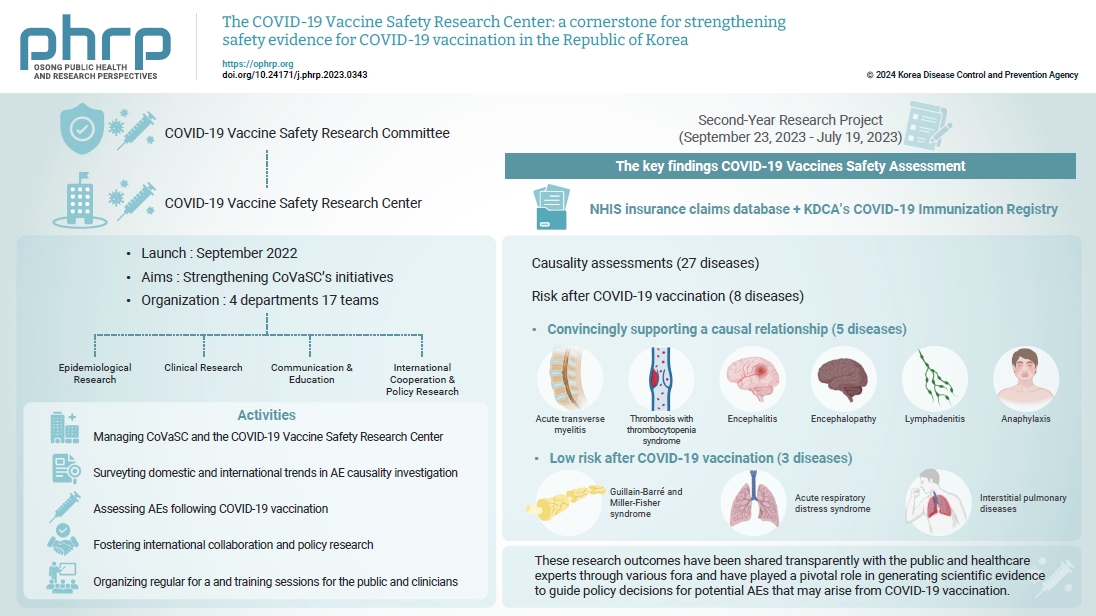Search
- Page Path
- HOME > Search
Special Article
- The COVID-19 Vaccine Safety Research Center: a cornerstone for strengthening safety evidence for COVID-19 vaccination in the Republic of Korea
- Na-Young Jeong, Hyesook Park, Sanghoon Oh, Seung Eun Jung, Dong-Hyun Kim, Hyoung-Shik Shin, Hee Chul Han, Jong-Koo Lee, Jun Hee Woo, Jaehun Jung, Joongyub Lee, Ju-Young Shin, Sun-Young Jung, Byung-Joo Park, Nam-Kyong Choi
- Osong Public Health Res Perspect. 2024;15(2):97-106. Published online April 4, 2024
- DOI: https://doi.org/10.24171/j.phrp.2023.0343
- 966 View
- 42 Download
-
 Graphical Abstract
Graphical Abstract
 Abstract
Abstract
 PDF
PDF 
- The COVID-19 Vaccine Safety Research Committee (CoVaSC) was established in November 2021 to address the growing need for independent, in-depth scientific evidence on adverse events (AEs) following coronavirus disease 2019 (COVID-19) vaccination. This initiative was requested by the Korea Disease Control and Prevention Agency and led by the National Academy of Medicine of Korea. In September 2022, the COVID-19 Vaccine Safety Research Center was established, strengthening CoVaSC’s initiatives. The center has conducted various studies on the safety of COVID-19 vaccines. During CoVaSC’s second research year, from September 29, 2022 to July 19, 2023, the center was restructured into 4 departments: Epidemiological Research, Clinical Research, Communication & Education, and International Cooperation & Policy Research. Its main activities include (1) managing CoVaSC and the COVID-19 Vaccine Safety Research Center, (2) surveying domestic and international trends in AE causality investigation, (3) assessing AEs following COVID-19 vaccination, (4) fostering international collaboration and policy research, and (5) organizing regular fora and training sessions for the public and clinicians. Causality assessments have been conducted for 27 diseases, and independent research has been conducted after organizing ad hoc committees comprising both epidemiologists and clinical experts on each AE of interest. The research process included protocol development, data analysis, interpretation of results, and causality assessment. These research outcomes have been shared transparently with the public and healthcare experts through various fora. The COVID-19 Vaccine Safety Research Center plans to continue strengthening and expanding its research activities to provide reliable, high-quality safety information to the public.
Original Article
- Evidence Gap on the Prevalence of Non-conventional Risk Factors for Type 2 Diabetes in Iran
- Abdolreza Shaghaghi, Ali Ahmadi
- Osong Public Health Res Perspect. 2014;5(5):292-297. Published online October 31, 2014
- DOI: https://doi.org/10.1016/j.phrp.2014.08.002
- 2,788 View
- 18 Download
- 3 Crossref
-
 Abstract
Abstract
 PDF
PDF - Objectives
Robust scientific evidence exists about the role of non-conventional risk factors in type 2 diabetes worldwide. The current epidemiological pattern of the disease in Iran suggests a precipitating role for these non-conventional risk factors. This review was performed to examine the research evidence suggesting a higher prevalence of non-conventional type 2 diabetes risk factors in Iran.
Methods
MeSH keywords were applied to search several databases, including PUBMED, MEDLINE, AMED, EMBASE, Iran DOC, and the Scientific Information Database without a time limit from inception to September 2011. The quality of the non-interventional and population-based studies on Iranians included in these databases was assessed by the authors and any disagreement was resolved with consensus.
Results
The literature search yielded 1847 publications, of which 62 were included in this study after eliminating non-relevant and overlapping papers. No study was found that verified a higher prevalence of the non-conventional type 2 diabetes risk factors in the Iranian population.
Conclusion
The identified evidence gap about the role of prominent non-conventional risk factors of type 2 diabetes in the Iranian population could be a major caveat in the application of an evidence-based approach to endorse or reject existing hypothesis about these risk factors. Studies on the prevalence of non-conventional biomarkers of type 2 diabetes among Iranians could be a promising area of research. -
Citations
Citations to this article as recorded by- Application of Pender’s health promotion model for type 2 diabetes treatment adherence: protocol for a mixed methods study in southern Iran
Nahid Shahabi, Zahra Hosseini, Teamur Aghamolaei, Amin Ghanbarnejad, Ahmad Behzad
Trials.2022;[Epub] CrossRef - Prevalence and determinants of diabetes and prediabetes in southwestern Iran: the Khuzestan comprehensive health study (KCHS)
Sanam Hariri, Zahra Rahimi, Nahid Hashemi-Madani, Seyyed Ali Mard, Farnaz Hashemi, Zahra Mohammadi, Leila Danehchin, Farhad Abolnezhadian, Aliasghar Valipour, Yousef Paridar, Mohammad Mahdi Mir-Nasseri, Alireza Khajavi, Sahar Masoudi, Saba Alvand, Bahman
BMC Endocrine Disorders.2021;[Epub] CrossRef - Association of modified Nordic diet with cardiovascular risk factors among type 2 diabetes patients: a cross-sectional study
Elnaz Daneshzad, Shaghayegh Emami, Manije Darooghegi Mofrad, Sahar Saraf-Bank, Pamela J. Surkan, Leila Azadbakht
Journal of Cardiovascular and Thoracic Research.2018; 10(3): 153. CrossRef
- Application of Pender’s health promotion model for type 2 diabetes treatment adherence: protocol for a mixed methods study in southern Iran



 First
First Prev
Prev


